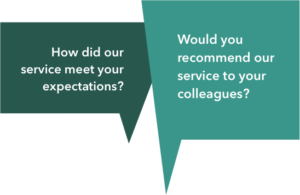When you meet a customer’s expectations, you make them happy. That’s the basic concept behind customer satisfaction. Sometimes, however, the potential value of your product or service outstrips customer expectations. Though the customer may be content, you can find ways to exceed expectations, thereby providing a service that truly provides the value a customer needs.
By pursuing customer lifetime value, you not only meet immediate customer expectations but set them up for sustainable future growth. Giving customers what they want will make them happy today. Maximizing the value they derive from the product and their partnership with your enterprise will keep them happy well into the future.
What is Customer Satisfaction?
Customer satisfaction is the result of customer expectations meeting the product or service reality. It can be better understood in contrast to two other terms: customer experience and customer success:
- Customer satisfaction describes whether a product or service met expectations. Did it do what it was supposed to do?
- Customer experience describes how easy-to-use and effective a product or service was. Was it enjoyable to use the product or interact with the team?
- Customer success is concerned with the value a customer derives from the product or service. Did it help them meet their business goals?
These concepts all work together. Consider a Microsoft certified partner’s efforts to fit out a client. Customer satisfaction metrics will provide feedback on how effective the install was and how it met a customer’s immediate communications concerns. The customer’s experience of the product, how it felt actually using it, will inform whether it meets expectations. Then, based on that information, the customer success team can determine how the service could be incorporated into a unified communications strategy so that the customer enjoys the maximum value and is more likely to renew in the future.
How is Customer Satisfaction Tracked?
Customer satisfaction is generally understood in terms of CSAT or NPS scores. These metrics are valuable in revealing a customer’s emotional reaction to a service or product. They focus on queries like:

Answers to these questions help you define how well the product performed and if the customer success team is providing sufficient support.
CSM sentiment is also something you will want to look at. In order to track customer satisfaction, you should consider what else a CSM has noted about the customer throughout their journey. For instance, what did the customer ask for? Were there promises you followed through on?
Now, once you have this information, it’s time to use it to optimize the customer experience.
Customer Satisfaction in the Customer-Centered Economy
The customer-centered economy is defined by subscription services, short-term and low-investment options, and a constant cycle of renewal or opt-out. So, if customers don’t see value in their service partnerships, they can walk away without penalty. This shifting market means the bulk of customer value is achieved through recurring revenue rather than a single sales event. To maintain and grow that revenue stream, you have to continually nurture your customers.
Customer satisfaction has a big role to play in that process. And you can strengthen your customer satisfaction efforts by employing best practices across three stages of the customer journey:
- Onboarding
- Adoption
- Escalation
Customer Satisfaction Best Practices: Onboarding
Onboarding is the critical first step that can make or break a customer relationship. It is also the first time the expectations created during the sale are put to the test. Keeping customers satisfied throughout the process eases the transition into adoption and the first customer experience of value and ROI.
At this time, you should know exactly what the customer wants to gain from the product or the partnership with your enterprise, what problem needs a solution. Customer satisfaction efforts should be focused on demonstrating how the customer can practically integrate the product into their daily workflows in order to meet those needs. This means prioritizing features that have a direct impact on customer business goals. To increase customer satisfaction, you need to rapidly prove your ability to deliver value and assist customers in attaining their objectives. Be sure to develop a standardized process that allows you to consistently onboard customers in a quick, efficient fashion.
Customer Satisfaction Best Practices: Adoption
One of the central tenants of customer success is maintaining close contact with customers throughout their journey. By understanding how the customer uses the product and the goals they are targeting, you can proactively engage with them to grow product value.
Once the customer exits onboarding and is using the product in their daily workflow—the adoption phase—you have to introduce and maintain regular contact, both directly and through data monitoring. This includes setting and celebrating goals and offering personalized support. It’s critical that no customer slips through the cracks during this phase, so use standardized processes and set up automated triggers that will alert you if a customer is failing to fully adopt the product. By striving to understand the customer experience and implementing targeted engagements, you’ll be better able to meet and exceed expectations.
Customer Satisfaction Best Practices: Escalation
It may seem cliché, but crisis really is an opportunity. A customer who experiences a satisfactory response to an escalation is more likely to be loyal than one who never endured a problem at all. The reason? You can greatly impress customers with the way you handle their concerns. Providing a personalized and timely resolution proves your commitment to your customers and gives you the chance to exceed their expectations. Sometimes a “pleasant surprise” can only come after an unwanted event.
By monitoring product usage, you should be able to identify early warning signs and take proactive steps before an escalation occurs. Still, escalations will happen, and then you need to act quickly to resolve the problem. This begins with the crucial first response; it has to be personalized, it has to be prompt, and it has to establish realistic expectations about service resumption. Then, take actions to prove you can live up to customer expectations in times of trouble. Make sure every team member knows the correct way to handle escalations so that you are providing a consistent experience for every customer.
Use Software to Improve Customer Satisfaction
In order to meet customer expectations, you need to understand their business needs. As such, you must gather every piece of information available on how they use the product and how it relates to their goals. Doing so manually is quite tedious and time-consuming, though, especially if you have many customers. The solution? Use customer success software to streamline the process.
By drawing on everything from customer satisfaction scores to feature usage metrics, license utilization and much more, a customer success platform provides an evolving picture of the customer experience. This data can be combined to generate a customer health score that gives a clear, timely indication of how a customer is doing. These monitoring activities can also be automated to provide direct alerts whenever there’s a change in the customer experience. You can be prompted to act as soon as a customer’s usage rate drops, they have a support ticket open for too long, or they have a large number of support tickets, for example. This makes it easier to effectively monitor a customer’s progress and proactively guide them to make sure customer satisfaction remains high.
With this clear understanding of the customer, it’s far easier to meet and exceed customer expectations. And by continuing to work toward increasing the value your customers realize from your product, you can build a long term, mutually beneficial relationship.
Totango gives you the day-to-day understanding you need to keep your customers satisfied. With the ability to collect and analyze any sort of metric, our platform can guide your customer satisfaction efforts. Request a demo or explore Spark to learn more.

